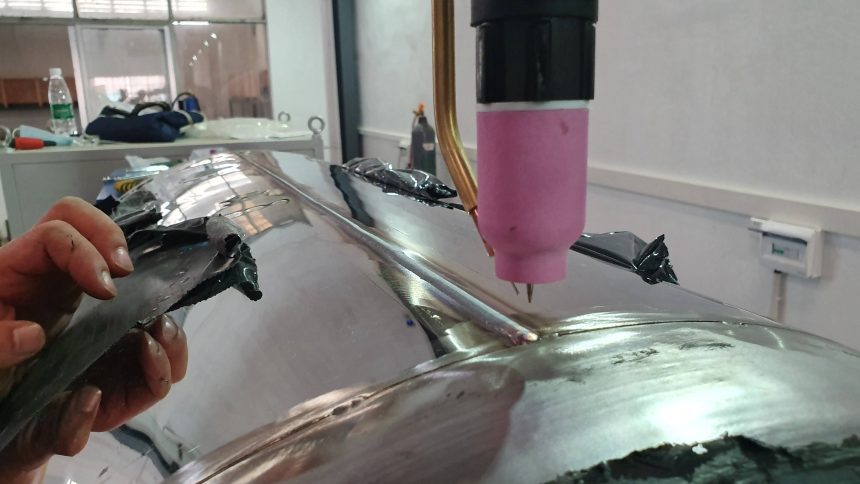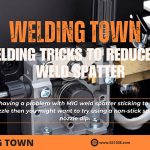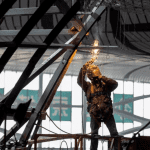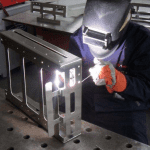Argon welding is also known as gas tungsten arc welding (GTAW) or tungsten inert gas (TIG) welding. This type of welding involves using an inert gas such as argon as a shield for the weld puddle while electricity passes through a non-consumable tungsten electrode that is held close enough to the workpiece to generate an arc. Argon welding has several advantages compared to arc welding, including better control over heat input, which allows for more precise welds with less chance of overheating; increased flexibility due to its ability to weld multiple types of metals; and less smoke and fumes during operation, resulting in improved air quality in the workspace. However, argon welding requires more skill than arc welding due to its greater complexity and costlier equipment requirements.
However, argon welding requires more skill than arc welding due to its greater complexity and costlier equipment requirements.
Welding Town
The welding current of tungsten arc welding is usually selected according to the material, thickness and spatial position of the workpiece. When the welding current increases, the melt depth increases and the width and residual height of the weld increases slightly, but rarely.
The arc voltage of tungsten arc welding is mainly determined by the arc length, the arc length increases, the arc voltage increases, the weld width increases, and the melt depth decreases. The arc is too long when the arc voltage is too high, easily caused by the failure to weld through and edge biting, and the protective effect is not good.
But the arc can not be too short, the arc voltage is too low, the arc is too short, the wire to send easy to touch the tungsten electrode caused by a short circuit, so that the tungsten electrode burns, but also easy to clip tungsten, so usually make the arc length is approximately equal to the tungsten electrode diameter.
When the welding speed increases, the melting depth and melt width decrease, when the welding speed is too fast, it is easy to produce unfused and unwelded, when the welding speed is too slow, the weld is very wide, and may also produce welding leakage, burn through and other defects. Manual tungsten arc welding, usually according to the size of the molten pool, the shape of the molten pool and both sides of the fusion at any time to adjust the welding speed.
1. Nozzle diameter
Nozzle diameter (refers to the inner diameter) increases, should increase the flow of shielding gas, when the protected area is large, the protection effect is good. However, when the nozzle is too large, not only makes the consumption of argon gas increase, and not easy to observe the welding arc and welding operations. Therefore, the diameter of the nozzle is usually 8mm to 20mm.
2. The distance between the nozzle and the weld
The distance between the nozzle and the weld is the distance between the nozzle surface and the workpiece, the smaller the distance, the better the protection effect. Therefore, the distance between the nozzle and the weld should be as small as possible, but too small will not be easy to observe the molten pool, so usually take the nozzle to the weld between the distance of 7mm ~ 15mm.
3. Tungsten electrode extension length
To prevent the arc from overheating and burning the nozzle, the tungsten tip should usually extend beyond the nozzle. The distance from the tungsten tip to the end of the nozzle is the tungsten electrode extension length, the smaller the tungsten electrode extension length, the closer the distance between the nozzle and the workpiece, the better the protection effect, but too small will prevent the observation of the molten pool.
Usually, when welding butt joints, the tungsten electrode extension length is 5mm to 6mm; when welding fillet welds, the tungsten electrode extension length is 7mm to 8mm.
4. Gas protection method and flow rate
In addition to using a round nozzle to protect the welding area, tungsten arc welding can also be made into a flat nozzle (such as narrow gap tungsten arc welding) or other shapes according to the welding space. When welding root welds, the back of the weld is subject to oxidation by air contamination and must therefore be protected by back gas filling.
Argon and helium are the safest gases for backfilling when welding all materials. Nitrogen is the safest gas for back gas protection when welding stainless steel and copper alloys. The general inert gas back-fill protection gas flow range is 0.5 to 42L/min.
Protective airflow is weak, the protection effect is not good, easy to produce porosity and welding seam is oxidation and other defects; if the amount of airflow is too large, easy to produce turbulence, the protection effect is also not good, but also affect the stability of the arc burning.
When inflating the tube, an appropriate gas outlet should be left to prevent excessive gas pressure in the tube during welding. At the end of the root welding channel 25 to 50 mm before the end of the welding, to ensure that the gas pressure inside the tube filling can not be too large, in order to prevent the welding molten pool from blown out or the root in the concave. When using argon gas for back protection in tube welding, it is best to enter from below so that the air is exhausted upwards and so that the gas outlet is away from the weld.











